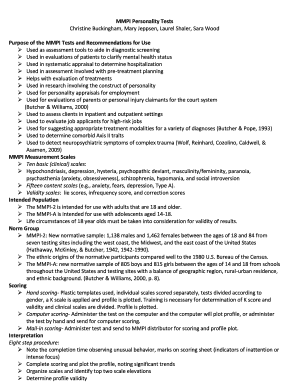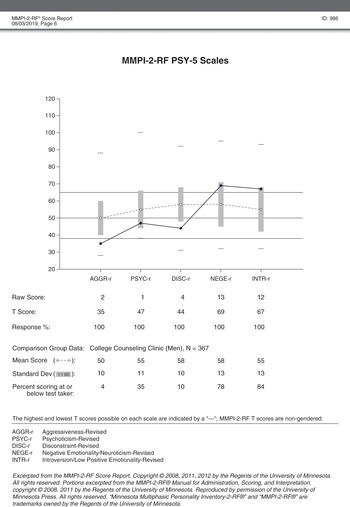


The 9 validity scales assess incongruent answering or deceptive test-taking and include: The RC scales were incorporated into the most current form of the MMPI, known as the Minnesota Multiphasic Personality Inventory-2 Revised Form, or the MMPI-2-RF, which was released in 2008 by Yossef Ben-Porath and Auke Telleger of the University of Minnesota. The MMPI-2-RF is composed of 338 items measured by 51 scales broken into 9 validity scales, 3 higher-order scales, the 9 RC scales, 23 specific problem scales, 2 interest scales, and 5 revised personality psychopathy scales. Arguments also exist that this information is limited in that it categorizes the responder rather than providing data on an individual patient within a personalized spectrum of behavior. The RC scales were devised to provide a streamlined interpretation and less overlap with an increased focus on the growth in understanding within psychiatry over the past 70 years. Combinations of high-scoring categories represent distinct psychiatric constructs rather than the nebulous findings of the original clinical scales tying the patient to a specific diagnosis.


RC9 or ‘hypomanic activation’ – energetic drive and desire for exertion In 2003, 9 restructured clinical or ‘RC’ scales were introduced as a prospective replacement for the original clinical scales. Despite further advancements, the MMPI-2 is still the most commonly administered version and has been translated into over 40 languages. Gendered differences were replaced with a nongendered standardized scoring. Test items were revised based upon a larger and more diverse sample size of 2600 attuned to a 6th-grade reading level. This assessment retains the original total of 567 items with the same corresponding 14 scales with the original number of questions from the test. Graham, Auke Tellegen, and Beverly Kaemme in 1989. These shortcomings led to the release of the MMPI-2 by James N. Studies have established biases in which misunderstanding or failure to identify with the content of questions culturally has led to underreporting or overreporting mental illness. This has been attributed to the original sample being a small group, mainly consisting of young rural Caucasian subjects from the Midwestern United States. Overarching criticisms to the original test center on its disparity in addressing psychopathy in social and ethnic minorities. Likewise, the instrument has been adapted to reflect such changes. The existence of the MMPI has been concurrent with vast reforms in societal convention and increased understanding of behavioral health. The first four ‘content scales’ judge the validity of the test attempt and include: The responses are then hand-scored and plotted on an X-Y graph a separate version is used for male and female respondents. The MMPI was developed in the 1930s and published through the University of Minnesota in 1942 by Stuart Hathaway and Charley McKinley using visitors of patients at the University of Minnesota hospital as a base sample in both theorizing constructs of psychiatric illness and fielding the instrument. Testing is administered through 567 true or false items using a booklet with an accompanying answer sheet. For psychiatric management, this aids in creating generalizable data relevant to a plethora of possible conditions. The most common treatment application of the test by providers is establishing or reevaluating care for an ambiguous clinical picture. This data can be used to draw conclusions about the test taker’s psychopathy or to interpret psychological characteristics compared to the norm. The Minnesota Multiphasic Personality Inventory (MMPI) is the most common psychometric test devised to assess personality traits and psychopathology.


 0 kommentar(er)
0 kommentar(er)
